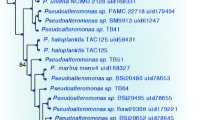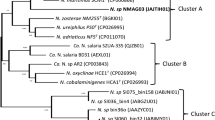Abstract
Bacteria belonging to the Pseudoalteromonas genus have important ecological implications in marine environments, playing a role in the control of microbial community as producers of bioactive molecules endowed with antifouling activity and able to antagonize larvae, fungi and bacteria, including important human pathogens. For these reasons, representatives of this genus are very promising for biotechnological and biomedical applications. In this work, we used different genome-scale approaches to infer the taxonomy of 38 Pseudoalteromonas representatives (most of which isolated from Antarctica) and whose complete genome has been sequenced. We show that an accurate re-evaluation of the real taxonomic relationships of Pseudoalteromonas representatives is needed since many inconsistencies with the current taxonomic annotation were observed. Moreover, data obtained with different genome-scale methods are consistent, confirming the reliability of the genomic approaches. On the basis of these data, we propose a re-annotation for some Pseudoalteromonas species. This proposal should be validated in the future by comparing the phenotypes of these strains.



Similar content being viewed by others
References
Cock, P. J., C. J. Fields, N. Goto, M. L. Heuer & P. M. Rice, 2010. The Sanger FASTQ file format for sequences with quality scores, and the Solexa/Illumina FASTQ variants. Nucleic Acids Research 38: 1767–1771.
Corchero, J. L., B. Gasser, D. Resina, W. Smith, E. Parrilli, F. Vázquez, I. Abasolo, M. Giuliani, J. Jäntti, P. Ferrer, M. Saloheimo, D. Mattanovich, S. Schwartz Jr, M. L. Tutino & A. Villaverde, 2013. Unconventional microbial systems for the cost-efficient production of high-quality protein therapeutics. Biotechnology Advances 31: 140–153.
Delcher, A. L, S. L. Salzberg & A. M. Phillippy, 2003. Using MUMmer to identify similar regions in large sequence sets. Current Protocols in Bioinformatics, 10–3.
Eddy, S. R., 2005. A model of the statistical power of comparative genome sequence analysis. PLoS Biology 3: e10.
Egan, S., S. James & S. Kjelleberg, 2002. Identification and characterization of a putative transcriptional regulator controlling the expression of fouling inhibitors in Pseudoalteromonas tunicata. Applied and Environmental Microbiology 68: 372–378.
Feller, G., 2013. Psychrophilic enzymes: from folding to function and biotechnology. Scientifica 2013: 1–28.
Galardini, M., A. Mengoni, E. G. Biondi, R. Semeraro, A. Florio, M. Bazzicalupo, A. Benedetti & S. Mocali, 2014. DuctApe: a suite for the analysis and correlation of genomic and OmniLog™ Phenotype Microarray data. Genomics 103: 1–10.
Gauthier, G., M. Gauthier & R. Christen, 1995. Phylogenetic analysis of the genera Alteromonas, Shewanella, and Moritella using genes coding for small-subunit rRNA sequences and division of the genus Alteromonas into two genera, Alteromonas (emended) and Pseudoalteromonas gen. nov., and proposal of twelve new species combinations. International Journal of Systematic Bacteriology 45: 755–761.
Geuten, K., T. Massingham, P. Darius, E. Smets & N. Goldman, 2007. Experimental design criteria in phylogenetics: where to add taxa. Systematic Biology 56: 609–622.
Giuliani, M., E. Parrilli, F. Sannino, G. A. Apuzzo, G. Marino & M. L. Tutino, 2014. Recombinant production of a single-chain antibody fragment in Pseudoalteromonas haloplanktis TAC125. Applied Microbiology and Biotechnology 98: 4887–4895.
Goris, J., K. T. Konstantinidis, J. A. Klappenbach, T. Coenye, P. Vandamme & J. M. Tiedje, 2007. DNA–DNA hybridization values and their relationship to whole-genome sequence similarities. International Journal of Systematic and Evolutionary Microbiology 57: 81–91.
Holmström, C., D. Rittschof & S. Kjelleberg, 1992. Inhibition of settlement by larvae of Balanus amphitrite and Ciona intestinalis by a surface-colonizing marine bacterium. Applied and Environmental Microbiology 58: 2111–2115.
Karlin, S., 1998. Global dinucleotide signatures and analysis of genomic heterogeneity. Current Opinion in Microbiology 1: 598–610.
Karlin, S. & C. Burge, 1995. Dinucleotide relative abundance extremes: a genomic signature. Trends in Genetics 11: 283–290.
Kim, M., H. S. Oh, S. C. Park & J. Chun, 2014. Towards a taxonomic coherence between average nucleotide identity and 16S rRNA gene sequence similarity for species demarcation of prokaryotes. International Journal of Systematic and Evolutionary Microbiology 64: 346–351.
Kobayashi, T., 2003. Pseudoalteromonas sagamiensis sp. nov., a marine bacterium that produces protease inhibitors. International Journal of Systematic and Evolutionary Microbiology 53: 1807–1811.
Larkin, M. A., G. Blackshields, N. P. Brown, R. Chenna, P. A. McGettigan, H. McWilliam, F. Valentin, I. M. Wallace, A. Wilm, R. Lopez, J. D. Thompson, T. J. Gibson & D. G. Higgins, 2007. Clustal W and Clustal X version 2.0. Bioinformatics 23: 2947–2948.
McAuliffe, J. D., M. I. Jordan & L. Pachter, 2005. Subtree power analysis and species selection for comparative genomics. Proceedings of the National Academy of Sciences 102: 7900–7905.
McCarthy, B. J. & E. T. Bolton, 1963. An approach to the measurement of genetic relatedness among organisms. Proceedings of the National Academy of Sciences of the United States of America 50: 156–164.
Médigue, C., E. Krin, G. Pascal, V. Barbe, A. Bernsel, P. N. Bertin, F. Cheung, S. Cruveiller, S. D’Amico, A. Duilio, G. Fang, G. Feller, C. Ho, S. Mangenot, G. Marino, J. Nilsson, E. Parrilli, E. P. Rocha, Z. Rouy, A. Sekowska, M. L. Tutino, D. Vallenet, G. von Heijne & A. Danchin, 2005. Coping with cold: the genome of the versatile marine Antarctica bacterium Pseudoalteromonas haloplanktis TAC125. Genome Research 15: 1325–1335.
Paitan, Y. & E. Z. Ron, 2014. Gram-Negative Pathogens: Overview of Novel and Emerging Resistant Pathogens and Drugs. In Antimicrobials, Springer, Berlin Heidelberg.
Papa, R., E. Parrilli, F. Sannino, G. Barbato, M. L. Tutino, M. Artini & L. Selan, 2013. Anti-biofilm activity of the Antarctic marine bacterium Pseudoalteromonas haloplanktis TAC125. Research in Microbiology 164: 450–456.
Papaleo, M. C., M. Fondi, I. Maida, E. Perrin, A. Lo Giudice, L. Michaud, S. Mangano, G. Bartolucci, R. Romoli & R. Fani, 2012. Sponge-associated microbial Antarctic communities exhibiting antimicrobial activity against Burkholderia cepacia complex bacteria. Biotechnology Advances 30: 272–293.
Papaleo, M. C., R. Romoli, G. Bartolucci, I. Maida, E. Perrin, M. Fondi, V. Orlandini, A. Mengoni, G. Emiliani, M. L. Tutino, E. Parrilli, D. de Pascale, L. Michaud, A. Lo Giudice & R. Fani, 2013. Bioactive volatile organic compounds from Antarctic (sponges) bacteria. New Biotechnology 30: 824–838.
Pardi, F. & N. Goldman, 2005. Species choice for comparative genomics: being greedy works. PLoS Genetics 1: e71.
Parrilli, E., R. Papa, S. Carillo, M. Tilotta, A. Casillo, F. Sannino, A. Cellini, M. Artini, L. Selan, M. M. Corsaro & M. L. Tutino, 2015. Anti-biofilm activity of Pseudoalteromonas haloplanktis TAC125 against Staphylococcus epidermidis biofilm: evidence of a signal molecule involvement? International Journal of Immunopathology and Pharmacology 28(1): 104–113.
Pride, D. T., R. J. Meinersmann, T. M. Wassenaar & M. J. Blaser, 2003. Evolutionary implications of microbial genome tetranucleotide frequency biases. Genome Research 13: 145–158.
Richter, M. & R. Rosselló-Móra, 2009. Shifting the genomic gold standard for the prokaryotic species definition. Proceedings of the National Academy of Sciences 106: 19126–19131.
Rippa, V., R. Papa, M. Giuliani, C. Pezzella, E. Parrilli, M. L. Tutino, G. Marino & A. Duilio, 2012. Regulated Recombinant Protein Production in the Antarctic bacterium Pseudoalteromonas haloplanktis TAC125. In Recombinant Gene Expression. Humana Press, New York.
Rosselló-Móra, R., 2012. Towards a taxonomy of bacteria and archaea based on interactive and cumulative data repositories. Environmental Microbiology 14: 318–334.
Schbath, S., 1997. An efficient statistic to detect over-and under-represented words in DNA sequences. Journal of Computational Biology 4: 189–192.
Schildkraut, C. L., J. Marmur & P. Doty, 1961. The formation of hybrid DNA molecules and their use in studies of DNA homologies. Journal of Molecular Biology 3: 595–616.
Stackebrandt, E. & J. Ebers, 2006. Taxonomic parameters revisited: tarnished gold standards. Microbiology Today 33(4): 152–155.
Stackebrandt, E., W. Frederiksen, G. M. Garrity, P. A. Grimont, P. Kämpfer, M. C. Maiden, X. Nesme, R. Rossello-Mora, J. Swings, H. G. Truper, L. Vauterin, A. C. Ward & W. B. Whitman, 2002. Report of the ad hoc committee for the re-evaluation of the species definition in bacteriology. International Journal of Systematic and Evolutionary Microbiology 52: 1043–1047.
Tamura, K., G. Stecher, D. Peterson, A. Filipski & S. Kumar, 2013. MEGA6: molecular evolutionary genetics analysis version 6.0. Molecular Biology and Evolution 30: 2725–2729.
Teeling, H., J. Waldmann, T. Lombardot, M. Bauer & F. O. Glöckner, 2004a. TETRA: a web-service and a stand-alone program for the analysis and comparison of tetranucleotide usage patterns in DNA sequences. BMC Bioinformatics 5: 163.
Teeling, H., A. Meyerdierks, M. Bauer, R. Amann & F. O. Glöckner, 2004b. Application of tetranucleotide frequencies for the assignment of genomic fragments. Environmental Microbiology 6: 938–947.
Vandamme, P., B. Pot, M. Gillis, P. De Vos, K. Kersters & J. Swings, 1996. Polyphasic taxonomy, a consensus approach to bacterial systematics. Microbiological Reviews 60: 407–438.
Wayne, L. G., D. J. Brenner, R. R. Colwell, P. A. D. Grimoxt, O. Kaniiler, M. I. Krichevsky, L. H. Moore, W. E. C. Moore, R. G. E. Murray, E. Stackebrandt, M. P. Starr & H. G. Truper, 1987. Report of the ad hoc committee on reconciliation of approaches to bacterial systematics. International Journal of Systematic Bacteriology 37: 463–464.
Wilmes, B., A. Hartung, M. Lalk, M. Liebeke, T. Schweder & P. Neubauer, 2010. Fed-batch process for the psychrotolerant marine bacterium Pseudoalteromonas haloplanktis. Microbial Cell Factories 9: 72.
Yu, M., K. Tang, J. Liu, X. Shi, T. Gulder, A. M. Tobias & X. H. Zhang, 2013. Genome analysis of Pseudoalteromonas flavipulchra JG1 reveals various survival advantages in marine environment. BMC Genomics 14: 707.
Acknowledgments
This work is supported by 2013 MIUR/PNRA grants (Programma Nazionale di Ricerche in Antartide) 2013/B4.02 and 2013/AZ1.04. Elena Perrin is financed by a “Fondazione Adriano Buzzati-Traverso” fellowship.
We are very grateful to two anonymous reviewers for their helpful suggestions and comments in improving the manuscript.
Author information
Authors and Affiliations
Corresponding author
Additional information
Guest editors: Diego Fontaneto & Stefano Schiaparelli / Biology of the Ross Sea and Surrounding Areas in Antarctica
Electronic supplementary material
Below is the link to the electronic supplementary material.
10750_2015_2396_MOESM1_ESM.xls
Supplementary File 1 Matrix of ANI values. Each cell contains the ANI value between two Pseudoalteromonas strains. Supplementary material 1 (XLS 34 kb)
10750_2015_2396_MOESM2_ESM.xls
Supplementary File 2 Matrix of TET values. Each cell contains the TET value between two Pseudoalteromonas strains. Supplementary material 2 (XLS 35 kb)
10750_2015_2396_MOESM3_ESM.pdf
Supplementary File 3 Comparison of Phylogenetic tree based on MLSA (left) and dendrogram obtained with ANI (right). Clusters with same members share the same colour in the two dendrograms. Supplementary material 3 (PDF 454 kb)
10750_2015_2396_MOESM4_ESM.pdf
Supplementary File 4 Comparison of dendrogram obtained with ANI (left) and dendrogram obtained with TNF (right). Clusters with same members share the same colour in the two dendrograms. Supplementary material 4 (PDF 215 kb)
10750_2015_2396_MOESM5_ESM.pdf
Supplementary File 5 Comparison of Phylogenetic tree (left) and dendrogram obtained with TNF (right). Clusters with same members share the same colour in the two dendrograms. Supplementary material 5 (PDF 455 kb)
10750_2015_2396_MOESM6_ESM.pdf
Supplementary File 5 Comparison of Phylogenetic tree (left) and dendrogram obtained with TNF (right). Clusters with same members share the same colour in the two dendrograms.. Supplementary material 6 (PDF 2462 kb)
Rights and permissions
About this article
Cite this article
Bosi, E., Fondi, M., Maida, I. et al. Genome-scale phylogenetic and DNA composition analyses of Antarctic Pseudoalteromonas bacteria reveal inconsistencies in current taxonomic affiliation. Hydrobiologia 761, 85–95 (2015). https://doi.org/10.1007/s10750-015-2396-9
Received:
Revised:
Accepted:
Published:
Issue Date:
DOI: https://doi.org/10.1007/s10750-015-2396-9




